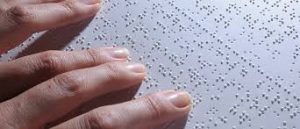 3D printing lends itself well to aiding the visually impaired. It has been used numerous times to create tactile maps, learning tools, tactile art, and other aids. The technology makes the printing of Braille on objects easy, as well. A new study takes a closer look at the use of 3D printing to produce embossed dot graphics for the purpose of helping the visually impaired. The goal of the study was to improve upon traditional methods of creating Braille, like embossing machines. Entitled “A Proposed Method for Producing Embossed Dots Graphics with a 3D Printer,” the study can be accessed here. The author of the study, Kazunori Minatani, is visually impaired himself.
3D printing lends itself well to aiding the visually impaired. It has been used numerous times to create tactile maps, learning tools, tactile art, and other aids. The technology makes the printing of Braille on objects easy, as well. A new study takes a closer look at the use of 3D printing to produce embossed dot graphics for the purpose of helping the visually impaired. The goal of the study was to improve upon traditional methods of creating Braille, like embossing machines. Entitled “A Proposed Method for Producing Embossed Dots Graphics with a 3D Printer,” the study can be accessed here. The author of the study, Kazunori Minatani, is visually impaired himself.
“The author designed this study to specifically take up the following challenge: develop a system that would convert data created using embossed dots graphics drawing software for a braille embosser into data that could be used with 3D CAD software,” the study explains. “The conversion would allow for completely customization of the size and shape of every dot, freeing us from the limitations in dot type associated with the braille embosser. Results are confirmed via physical measurements and tactile observation assessments.”
The biggest advantage, according to the study, that 3D printers have over traditional Braille embossers is that they can freely customize the arrangement and shapes of the dots. Converting embossed dots graphics drawing software to CAD data allowed for full customization of the sizes and shapes of the dots; the software Minatani designed was named Ed12scad. Edel is a piece of drawing software used for designing embossed dots graphics for the ESA 721 embosser, which can punch out three different dot sizes.

Three dots embossed by ESA721 (up-left), generated by 3D printer (down-left) and the evaluated embossed dots map (right)
“By converting data so that it can be edited on OpenSCAD, users can take the drawings they’ve made on Edel and revise them in SCAD data format on OpenSCAD as solid objects,” Minatani states. “The small, medium, and large dots included in the Edel data are converted into solid hemispheres on the surface of circular truncated cones in accordance with their respective sizes.”
By using a 3D printer, Minatani was able to produce larger dots than could be produced with the embosser. He created a tactile map using the 3D dots, and enlisted the input of other visually impaired people to assess the results of the study. The following conclusions were reached:
- The 3D models were not inferior to the embossed dots graphics produced on paper in terms of their expressive features
- Changing the three dot sizes made it easier to distinguish them in the 3D model compared to the paper embossed dots graphics. The large dots, in particular, were greatly improved in terms of palpability.
- The surface smoothness of the 3D model was inferior to that of the embossed dots graphic produced on paper.
- The abbreviated city names written on the map in Braille were not easy to read.
Although the results created using the 3D printer weren’t without their flaws, the study emphasized the freedom that 3D printing allows in terms of creating different shapes, sizes, and arrangements of dots, unlike the limits of the traditional Braille embosser. Using 3D printing also makes it easier to create objects with Braille printed directly on them. 3D printing can be used in a number of creative ways to bring “sight” to visually impaired people – through maps, 3D pictures, even 3D ultrasounds. With 3D printing technology, visually impaired people can experience the world in more ways than ever before.
Discuss this and other 3D printing topics at 3DPrintBoard.com or share your thoughts below.
Subscribe to Our Email Newsletter
Stay up-to-date on all the latest news from the 3D printing industry and receive information and offers from third party vendors.
You May Also Like
Precision at the Microscale: UK Researchers Advance Medical Devices with BMF’s 3D Printing Tech
University of Nottingham researchers are using Boston Micro Fabrication‘s (BMF) 3D printing technology to develop medical devices that improve compatibility with human tissue. Funded by a UK grant, this project...
3D Printing Webinar and Event Roundup: April 21, 2024
It’s another busy week of webinars and events, starting with Hannover Messe in Germany and continuing with Metalcasting Congress, Chinaplas, TechBlick’s Innovation Festival, and more. Stratasys continues its advanced training...
3D Printing Webinar and Event Roundup: March 17, 2024
It’s another busy week of webinars and events, including SALMED 2024 and AM Forum in Berlin. Stratasys continues its in-person training and is offering two webinars, ASTM is holding a...
3D Printed Micro Antenna is 15% Smaller and 6X Lighter
Horizon Microtechnologies has achieved success in creating a high-frequency D-Band horn antenna through micro 3D printing. However, this achievement did not rely solely on 3D printing; it involved a combination...






























